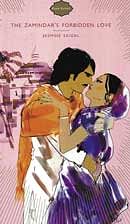Sari-rippers

A few years ago, I saw this joke T-shirt which featured an elaborate print of a king and queen embracing, visible through the window of a palace, all drawn in Rajasthani-painting style. The punch line below read, ‘Your palace or mine?’
Reading through the Kama Kahani series reminded me strongly of that image. The same detailed attention to describing exotic Indian settings, coupled with a cheap reliance on clichés while composing the story. All of the blame cannot be laid on the writers, however. The series is intended to be an ‘Indian version of Mills and Boon’, so it is understandable that it would share the faults of mass-produced short romance novels. The hero has to be tall, dark and handsome, the heroine beautiful and perfectly-proportioned with a spark of individualism. There has to be an instant attraction between the two from the first time they meet, and a set of misunderstanding and situations that keep them apart till the last chapter, when they have a hot, explicit, scene.
It’s a bit of a shame, really, because a storyline that belonged to the periods described in the books would have worked fine. The Mills and Boon standard characters, however, are so modern and independent that they stand out like sore thumbs. Sample Nandini’s line from Mistress to the Yuvraj: “A kiss is just a kiss, Yuvraj, and you, of all people, should know that.” Weird, considering that this is a 17th-century Rajasthani girl talking. The only concession made to make them Indian is to turn their skin ‘golden-coloured’. Of the three, The Zamindar’s Forbidden Love does do a somewhat better job of integrating the characters, probably because the setting (Kolkata) is more urban.
For all the variety of their settings, all the books are set during the times when the British were around. The charitable explanation would be that this was done to add tension to the atmosphere. The more likely one, however, is that other books, written in English, were used as source material for these books, and such books are most likely to be written during the British era. As the author of Ghazal in the Moonlight, Alessandra Shahbaz, said in an interview, “Innumerable colonial documents describe the awe British traders felt when first glimpsing Lucknow city’s domes and spires...” Seen from this angle, these books are derivative works, relying on details from other Indian writing in English and British records — so it wouldn’t be surprising if they’re inaccurate about the details of the locale.
The British being around brings up another interesting problem: how come everyone is able to speak to each other? It’s a little strange when Shameena, the 18-year-old heroine of Ghazal in the Moonlight, converses easily with Nicholas Winthrop, a British officer. There are no discernable differences in ‘voices’; everyone is equally fluent in flowery English.
The books do bring in some subplots and ideas that are typically Indian — these are a relief from the declarations of love. Nandini dresses up like a man and takes part in a sword fighting competition in Mistress to the Yuvraj (Of course, the marketing folks have used this as an excuse to label the book as ‘just like Jodhaa Akbar!’). Asef, the hero of Ghazal in the Moonlight is desperate to find out how his warrior mother died, and he finally finds out because Shameena’s been carrying a vital clue to the mystery. The characters of The Zamindar’s Forbidden Love all wind up involved in the freedom struggle.
The settings of each of the books are very thoroughly described — down to the clothes of all the characters, the rooms they are in, and the food they’re eating. Each of the three writers has her own quirks here: Alessandra Shahbaz(Ghazal) focuses on foliage, Sanyogita Rathore(Yuvraj) focuses on all the Rajasthani names for the clothes, and food (and none of the sweets, surprisingly), and Jasmine Saigal (Zamindar) has a fetish for saree patterns and explaining Bengali festivals. There seems to be a quota of Indian-exotic words per page, which gets tiresome: people are always fiddling with their dupattas, seeing hibiscus or jasmine flowers, eating sandesh, or staring down tigers.
Are all the three books of the same standard? I’d say The Zamindar’s Forbidden Love is the best of the three, and the other two share a joint third (or even fourth) place. Zamindar... is also the longest of the three, and actually makes an attempt to explain the characters’ motivations and how they fit into the environment. Bollywood-style, it even starts with the leads meeting each other for the first time when they’re kids, and later has the story move through several levels of society in Bengal.
Overall, though, you emerge from reading each of the books without much sympathy for the characters. I was hard-pressed to remember the names of the leads two days after the books were done. One can imagine a certain sort of teenage girl, someone who devours Mills and Boon, taking a diversion to read these books. It probably won’t attract any new readers, though. Someone who really wants to read Indian romances will want more than just characters with ‘golden’ skin.
Deccan Herald is on WhatsApp Channels| Join now for Breaking News & Editor's Picks